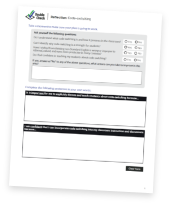Strategy: Code-switching
Check-Up Menu > Code-switching
How To
- Reflect on your own personal beliefs and experiences related to the use of Standard English, other languages, and dialects. Determine if you need to discuss your thoughts or any biases with a trusted colleague or your Double Check coach.
- Notice when students are code-switching in your classroom. Make note of some of the most common phrases that you hear them use.
- If it is authentic to you and appropriate, consider using code-switching during informal conversations with students to build rapport. For example, some students might say, “My bad,” instead of, “I’m sorry,” or, “You being extra,” instead of, “You are being dramatic,” and a teacher might choose to use these phrases as well.
- Correcting students when they code-switch can damage the student-teacher relationship. It can be more effective to talk to students about when language is more productive and in what contexts (Wheeler & Swords, 2010).
- When grading students, consider not penalizing them when they use do not use Standard English, but instead using a contrastive analysis approach to help students compare their “home language” to Standard English. Strategy Tool #1 will help you understand how to use contrastive analysis in your classroom.
- You can plan lessons using a literary text that incorporates different varieties of language. It may be easier or more comfortable for you to use examples from the book to illustrate code-switching before using specific examples from students in your classroom. See below for a list of texts that you could use.
Brown, M., & Palacios, S. (2011). Marisol McDonald doesn’t match/Marisol McDonald no combina. New York, NY: Children’s Book Press.
Cisneros, S. (1984). The house on Mango Street. New York, NY: Bloomsbury. Compton, J., & Compton, L. (1994).
Ashpet: An Appalachian tale. New York, NY: Holiday House. Flournoy, V., & Pinkney, J. (1985). The Patchwork Quilt. New York, NY: Dial.
Greenfield, E., & Gilchrist, J. S. (1993). William and the good old days. New York, NY: Harper Collins.
Herron, C., & Cepeda, J. (1998). Nappy hair. New York, NY: Dragonfly Books.
Lowell, S., & Manning, J. (2001). Cindy Ellen: A wild Western Cinderella. New York, NY: Harper Collins.
McKissack, P., & Isadora, R. (1986). Flossie and the fox. New York, NY: Scholastic.
McKissack, P., & Pinkney, J. (1988). Mirandy and Brother Wind. New York, NY: Knopf.
McKissack, P., & Pinkney, J. (1989). Nettie Jo’s friends. New York, NY: Knopf.
Polacco, P. (1994). Pink and Say. New York, NY: Philomel.
Rawls, W. (1961). Where the red fern grows. New York, NY: Random House Children’s Books.
Schachner, J. (2005). Skippyjon Jones. New York, NY: Dutton Children’s Books.
Swados, E. & Cepeda, J. (2002). Hey you! C’mere! A poetry slam. New York, NY: Arthur A. Levine.
Williams, S. A., & Byard, C. (1992). Working cotton. San Diego, CA: Harcourt.
Retrieved from: https://modules.sanfordinspire.org/wp-content/uploads/2017/06/Contrastive_Analysis_Learn_and_Affirm_Language_Resource.pdf

Reflection

Goal Setting

References to Other Relevant Resources:
Wheeler, R. S. (2019). Attitude change is not enough: Disrupting deficit grading practices to disrupt dialect prejudice. Proceedings of the Linguistic Society of America, 4(1), 10-1. https://modules.sanfordinspire.org/wp-content/uploads/2017/06/Contrastive_Analysis_Learn_and_Affirm_Language_Resource.pdf